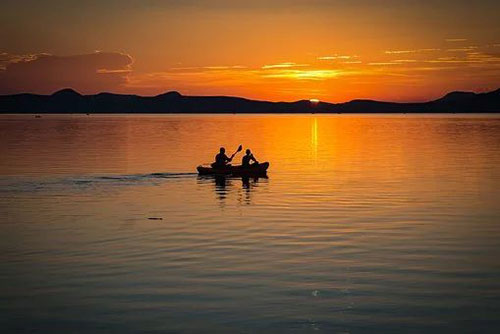An EU-funded project has developed a water tourism network along the Lower Tisza river and its tributary, the Körös in the North and South Great Plain regions of Hungary. The network consists of 12 riverbank stops for people exploring the area’s waterways with canoes, kayaks or stand-up paddle boards. The stops are located at Szolnok, Tiszakécske, Mindszent, Szeged, Gyula, Sarkad, Doboz-Szanazug, Békés, Köröstarcsa, Gyomaendrőd, Kunszentmárton and Csongrád.
- 29 January 2020
A modern interface is being created, with all of the area's attractions and accommodation available online, allowing everyone to plan their destinations and itineraries and to learn the basics of canoe camping. It is important to emphasise that our canoeing clubs will act as mentors in the water tourism network, helping younger and older people to learn the basic rules.
Tasks under the project included the construction or renovation of the stops, the purchase of boats, paddles, motorboats and trailers for transporting canoes and kayaks, and the development of services necessary for the operation of the network.
As well as moorings such as floating jetties, facilities at stops can comprise accommodation for visitors, pitches for tents, washing and cooking areas, communal spaces, boat rental services and boards with tourist information.
Bicycles can be rented at some of the stops, although this service is not provided as part of the project. Depending on the availability of infrastructure, Wi-Fi access may also be available for guests.
To promote the network, a detailed marketing concept has been developed and an interactive web-based platform (viziturapont.hu) is under construction, although the platform is financed separately from the project. It contains details of places of interest and accommodation at the various locations and helps canoeists and kayakers choose their destinations and plan their itineraries. In addition, a 40-page brochure and an information leaflet have been published for distribution to hotels and restaurants.
Part of a wider programme
Establishment of the network on the Lower Tisza and Körös rivers is part of a wider water tourism initiative under which similar facilities, managed by different organisations, have been built along other rivers across Hungary, including the Upper Tisza, the Bodrog, the Danube, the Hernád, the Ipoly, the Rába, the Sió, the Túr and the Zagyva. The initiative also covers Balaton, Hungary’s largest lake, and lesser-known lakes such as Lake Deseda, Lake Gébárti, Lake Gyékényes and the Pátkai and Tisza reservoirs.
This in turn constitutes a component of an even more broad-based tourism programme called Bejárható Magyarország, or Travelling Hungary. The main objective of Travelling Hungary is to enable tourists of all ages to discover what Hungary has to offer through active leisure and sporting pursuits.
The programme is based around five different travelling options, all of which make the country and its natural and cultural treasures more accessible: along with water tourism, these are hiking, cycling, horse riding and sailing. In fostering the development of new tourist facilities, Travelling Hungary aims to strengthen connections between the five modes of transport it supports.
A significant contribution to the tourist offer
Development of the stops along the Lower Tisza and the Körös was carried out following the attribution of permits by public authorities, the launch of public procurement procedures related to construction work and provision of equipment, and the subsequent conclusion of contracts.
The network represents a significant contribution to the expansion of domestic and international tourism in the settlements near the two rivers. Moreover, the project aims to encourage people, particularly the young, to take up canoeing and kayaking. It is expected that the network will increase visitor numbers in the area by some 10 000 a year and generate HUF 139 000 000 (around EUR 415 000) in revenue within the first five years of its operation.
Total investment and EU funding
Total investment for the project “Complex development of water tourism on the Lower Tisza and Körös” is EUR 1 289 423, with the EU’s European Regional Development Fund contributing EUR 1 096 009 through the “Economic Development and Innovation” Operational Programme for the 2014-2020 programming period. The investment falls under the priority “Tourism”.

